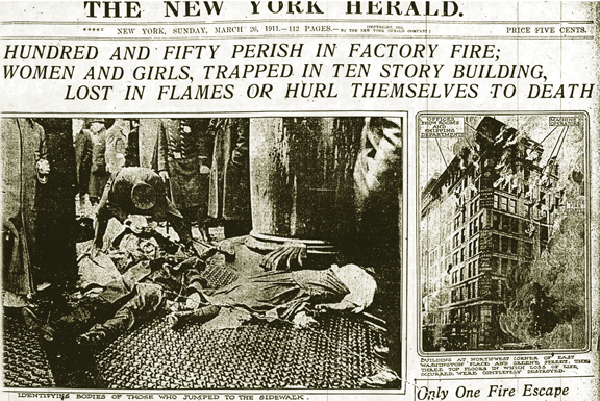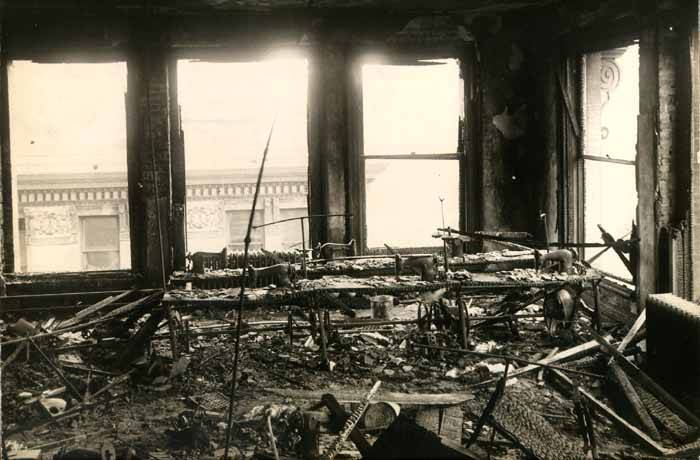The Fire that Changed America
If you stroll by the corner of Washington Place and Greene Street today, you'll see the purple flags of NYU and twenty-something year old kids in the midst of their college education getting ready for their labor law-protected future. But exactly 100 years ago, on that same corner, young workers burned alive or jumped out of the windows of their factory to escape a fire caused by disgraceful working conditions. The Triangle Shirtwaist Company occupied the top three floors of what was then known as the Asch building. It employed mostly female work force, Italian or European Jewish immigrants who often spoke little or no English. The girls and young women aged 15-23 endured low wages, unthinkably long hours of garmenting and unsafe labor conditions.
That March afternoon, 129 of them, plus 17 male co-workers, never returned home; many were found charred beyond recognition, while others leaped to their death in order to escape the flames.
The deadliest workplace catastrophe of New York City took place on March 25, 1911, and on its centennial, the Remember the Triangle Fire Coalition has been coordinating a citywide commemoration. The group of volunteers made up by artists, activists, and academics not only leads the remembrance efforts but it has been advocating the establishment of a permanent public art memorial.
The women of the Triangle Shirtwaist Factory were paid $6.00 a week. They sat hours before their sewing machines in order to make ends meet. That afternoon a cigarette butt thrown in the wrong bin of discarded fabric caused a deadly blaze. When somebody screamed “fire” the panicked workers ran to the small exit doors. They were locked. Trapped inside, many jumped out of windows or down an empty elevator shaft. Those who tried to save their lives through a fire escape died crushed to the ground when the raging heat melted it. To make matters worst, at that time, the fire department hoses and ladders were unable to reach above the sixth floor. While the flames were enveloping the eighth and ninth floors of the Asch building, the workers of the upper floors were able to escape. Among them were the owners of the building, Max Blanck and Isaac Harris, who were also successful in avoiding manslaughter charges. But the indignation and social protest which followed the Triangle carnage couldn't be put out.
Somehow the personal tragedy turned political. The Triangle Shirtwaist Factory gruesome massacre fostered fundamental reforms and it became a turning point in the path to workplace safety and social justice. In the upcoming HBO film “Triangle: Remembering the Fire” the historian Jo Ann E. Argersinger, quoting the labor activist Samuel Gompers, who in the years after the fire led an investigation about the city's sweatshops, said “women had to burn first in order for this to happen.” But it did happen. The outcry following the gruesome events of that March afternoon brought about the creation of the Life Safety Code, the Bureau of Fire Prevention and the New York State Factory Investigating Committee, with the National Women's Trade Union League (NWTUL) in the forefront of the fight for reforming working conditions.
The Triangle Fire sparked positive changes but inhuman conditions in many sweatshops around the world and workplace-related disasters continue to these days. Moreover, in a time in which unions are under attack - the fatal blow delivered to the labor movement in Wisconsin hit the papers last week, when Republican Governor Scott Walker succeeded in taking away nearly all collective bargaining rights from public workers - it is even more important to honor the young workers who died one hundred years ago. March 25th remains a fundamental date for all those who continue the fight for workers’ rights and safety. To learn more about the commemorative events – activism, education, and arts – visit the Remember the Triangle Fire Coalition web site.








































i-Italy
Facebook
Google+
This work may not be reproduced, in whole or in part, without prior written permission.
Questo lavoro non può essere riprodotto, in tutto o in parte, senza permesso scritto.